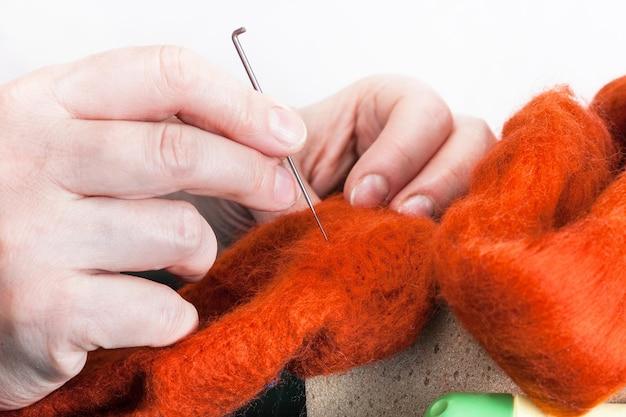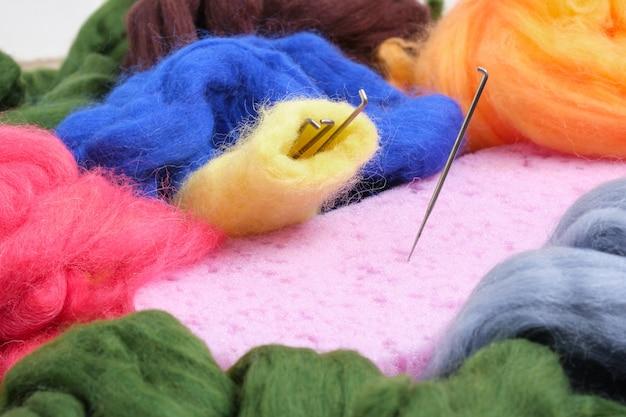Needle felting is a popular craft technique that involves using a special needle to create intricate designs and shapes with wool fibers. However, if you’re new to needle felting, you may be wondering what other materials you can use. One common question that often arises is whether yarn, specifically acrylic yarn, can be used for needle felting.
In this blog post, we will explore the possibilities and limitations of using yarn for needle felting. We’ll discuss the different types of yarn, their suitability for this craft, and alternative options for creating felted objects. Whether you’re a beginner or a seasoned needle felting enthusiast, this article will provide you with the information you need to create beautiful and unique felted creations using yarn. So let’s dive in and explore this fascinating world of needle felting!
Can I Use Yarn For Needle Felting
Have you ever looked at a ball of fluffy yarn and wondered if it could be used for needle felting? You’re not alone! Many crafters have pondered over this question, and today, we’re here to give you the lowdown on using yarn for needle felting.
The Art of Needle Felting
Before we dive into whether yarn is suitable for needle felting, let’s quickly go over what needle felting is. This delightful craft involves using a special needle, often with barbs on the tip, to repeatedly poke and intertwine fibers until they become tightly compacted and form a solid shape. The result? Adorable felted creations that can be anything from animals to miniature sculptures.
Yarn: Not the Go-To Material
While yarn is fantastic for knitting and crocheting, it’s not typically the go-to material for needle felting. Why? Well, yarn is made up of multiple strands of fibers loosely twisted together. This loose structure makes it difficult for the individual fibers to tangle and compact effectively when using a felting needle. Plus, the long fibers in yarn can sometimes create a fuzzy and less-defined texture, unlike the smooth and compacted finish achieved with traditional needle felting materials.
Challenges with Yarn Felting
Using yarn for needle felting can present a few challenges, one of which is achieving intricate details. The loose fibers of the yarn may not hold their shape as tightly as other felting materials, making it harder to create fine lines or small features.
Another consideration is the potential for the yarn to unravel during felting. As you repeatedly poke the fibers with a felting needle, the individual strands that make up the yarn may separate and become unraveled, causing frustration and hindering the felting process.
Special Cases: Yarn Blends and Core Felting
While yarn might not be the ideal material for intricate needle felting, there are a few special cases where it can be used effectively. First, yarn blends that incorporate a higher percentage of wool can work better for felting. These blends tend to have shorter fibers that interlock more easily, making them more suitable for needle felting.
Additionally, yarn can be used as a core material for a larger needle felting project. By wrapping a core of yarn (such as wool yarn) with a layer of felting wool or roving, you can create a base shape that is easier to work with and saves you on felting material.
In conclusion, while yarn may not be the most recommended material for intricate needle felting, it can still be used in certain situations. However, for the best results and more precise detailing, it’s generally advisable to stick to traditional needle felting materials like felting wool or roving. So go ahead, embrace the joy of needle felting, and let your creativity soar with the appropriate materials!
FAQ: Can I Use Yarn For Needle Felting
So, you’ve decided to embark on a needle felting adventure and now you’re wondering if you can use yarn for this craft. Well, you’ve come to the right place! In this FAQ-style guide, we’ll address some of the burning questions you may have about using yarn for needle felting. From the practical uses of felt balls to alternative materials for felting, we’ve got you covered!
What can I do with felt balls
Felt balls are incredibly versatile and can be used in various creative projects. You can make garlands to adorn your home, create jewelry pieces like necklaces or earrings, or even use them as decorative accents on clothing or accessories. Let your imagination run wild!
How do you attach felt balls
To attach felt balls, you can use glue or a needle and thread. If you choose to sew them, simply pass the needle through the ball and secure it by sewing it onto the desired surface. Alternatively, a dab of strong fabric glue will do the trick.
What materials do you need for needle felting
For needle felting, you’ll need a few essential materials: felting needles, felting foam pad or brush, and of course, wool roving. These supplies will ensure you have the necessary tools to bring your needle felting creations to life.
What is acrylic yarn best used for
Acrylic yarn is highly versatile and can be used for a wide range of projects. It’s perfect for creating cozy blankets, scarves, or hats, as it offers warmth and durability. Additionally, its affordability makes it an excellent choice for large-scale projects that require a substantial amount of yarn.
What is acrylic yarn good for
Acrylic yarn is great for beginners or those who prefer low-maintenance materials. Unlike natural fibers, acrylic yarn is easily washable and resistant to shrinking, making it ideal for creating everyday items like baby clothes or blankets that require frequent washing.
Can acrylic yarn be felted
Unfortunately, acrylic yarn cannot be felted through the traditional wet felting process. The fibers in acrylic yarn are not cohesive enough to bind and shrink together. However, don’t despair! There are alternative methods and materials you can explore to achieve a similar effect.
What kind of yarn do you use for felting
When it comes to needle felting, wool roving is the go-to material. Its natural properties enable the fibers to entangle and bind together when agitated with a felting needle. So, if you’re looking to dive into the world of needle felting, wool roving is your best bet!
What can you use instead of a felting needle
If you don’t have a felting needle on hand, fear not! There are alternatives you can use to achieve a similar effect. Some crafters have had success with using a regular sewing needle or even a toothpick to create the desired texture and compact the fibers.
Can you make felt balls from yarn
Absolutely! Making felt balls from yarn is a fun and creative project. Simply wrap the yarn tightly into a ball shape and then wet felt it by agitating it between your palms or using a felting tool. This will cause the yarn fibers to entangle and bind together, resulting in a felted ball.
Is acrylic yarn bad
No, acrylic yarn is not inherently bad. It has its own set of benefits, such as affordability and easy care. However, it’s worth noting that acrylic yarn is derived from synthetic materials and does not possess the same natural properties as fibers like wool or cotton.
Can silk be needle felted
Yes, silk can be needle felted! Silk fibers, just like wool, can be interlocked and bind together when subjected to the felting process. So, if you’re feeling experimental, give silk needle felting a try and see what unique textures and effects you can create!
Can you use cotton balls for needle felting
While cotton balls are soft and fluffy, they’re not typically suitable for needle felting projects. Cotton fibers don’t have the natural tendency to interlock and bind together like wool or other feltable materials do. It’s best to stick to wool roving or other recommended felting materials to ensure successful results.
Is cotton yarn toxic
No, cotton yarn is generally considered safe and non-toxic. It’s a natural fiber that is widely used in various textile applications, including knitting and crochet. However, as with any material, it’s recommended to purchase yarn from reputable sources that comply with safety regulations.
Can you do needle felting without wool
While wool is the traditional and most commonly used material for needle felting, you can experiment with other natural fibers such as alpaca, mohair, or even bamboo. These fibers possess similar properties to wool and can be successfully felted using the same techniques.
What is the difference between wet felting and needle felting
Wet felting and needle felting are two distinct techniques in the world of felting. Wet felting involves agitating wool fibers with hot water and soap to intertwine and create a solid piece of felt. On the other hand, needle felting uses special barbed needles to repeatedly poke and compact wool fibers together, creating intricate designs and shapes.
Can any fiber be felted
No, not all fibers can be felted. Feltability depends on the inherent characteristics of the fiber. Natural fibers like wool, alpaca, or mohair are ideal for felting due to their structure and ability to interlock. Synthetic fibers like acrylic or nylon, however, do not possess the necessary properties for felting.
Can acrylic yarn be used for needle felting
Unfortunately, acrylic yarn is not suitable for needle felting. The fibers in acrylic yarn are not designed to felt and will not bind together when subjected to the felting process. Stick to natural fibers like wool for your needle felting projects to ensure successful results.
Now that you have all the information about yarn and needle felting, it’s time to get your creative juices flowing! Grab your materials, feel the fibers, and let your imagination guide you to create beautiful and unique needle felted masterpieces. Happy felting!

